Inventories are essential to have complete clarity over the condition and contents of your rental property: without correct preparation, you not only risk a costly dispute, but you’ll also sow the seeds of worry in your tenants. The more documentation you have that you can agree on from the outset, the more professional you’ll look as a landlord and the more comfortable your tenants will feel.

However, not every inventory provides the protection that landlords expect. There are plenty of cases where the language and style used causes confusion and this can lead to an unsuccessful claim against the deposit. Whether you’re preparing a paper or digital inventory, you must ensure it is signed off by you (or your managing agent) and your tenants. But as you’ll discover below, there’s more to it than that.
If you own a rental property in the Salisbury area and you’d like to know more about best practice when preparing inventories, do get in touch. Call us for a chat on 01722 580059 or email us at info@piccoloproperty.co.uk - you’ll always find an expert ear happy to guide you.
Meanwhile, let’s take a look at how you can make your inventory the best it can be to give you, your property and your tenants maximum protection.
BEYOND BOX-TICKING
Some landlords still rely on a checklist-style inventory and these simply aren’t detailed enough to reflect the contents and condition of a property accurately. More than that, they’re completely useless when it comes to being clear about the condition of every fixture, fitting and, where supplied, furnishing.

We can’t stress enough that inventories are so much more than box-ticking exercises, and a correctly prepared report can easily run to 30+ pages - more if your property is furnished. There’s a lot of time involved in writing down every last detail, but even if you have complete confidence and trust in your tenants, it’s in both your best interests to go deep. So if your inventory is just a few pages long, it’s unlikely to be of any use in a dispute.
That’s why an inventory clerk is so invaluable. Not only do they save you the time and hassle of detailing every last thing yourself, but they’re also a third party with no emotional or financial attachment to the property. They’re guided only by what they see, and their expertise and independence give their inventories an extra layer of credibility, priceless if you end up in arbitration or the courts.
Remember: it’s your responsibility as a landlord to prove that any damages or repair costs are down to your tenants.
MIND YOUR LANGUAGE
Problems with disputes can often come down to the language used in the inventory. It’s not because they’re written in French or Norwegian, but because they use emotive and subjective words.
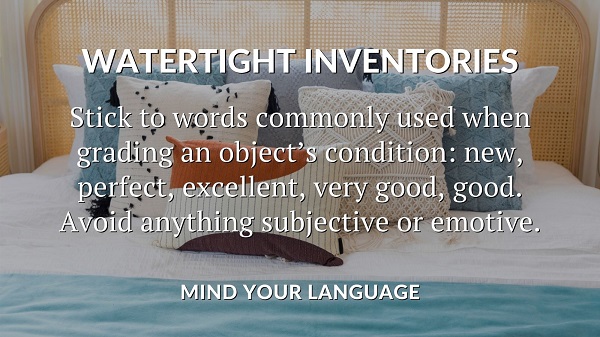
One example is the word lovely, which, in property terms, is best confined to an estate agent’s description of a charming location. It really shouldn’t form part of how you describe the contents or condition of anything in your property. Stick to words commonly used when grading an object’s condition: new, perfect, excellent, very good, good. Hopefully, you’ll have no cause to use below average, poor or unusable, but if you do, you’re best off fixing anything in that category for the sake of starting your tenancy on the right foot.
Emotive language may well come from your pride in your property and generally appears when self-managing landlords write their own inventory. It’s completely understandable, but it’s no help to you in the event of a dispute. Keep it neutral and objective.
THE DEVIL’S IN THE DETAIL
Inventories aren’t just about listing objects; they’re about giving an accurate picture of your property’s condition and presentation when you hand over the keys to your tenants.
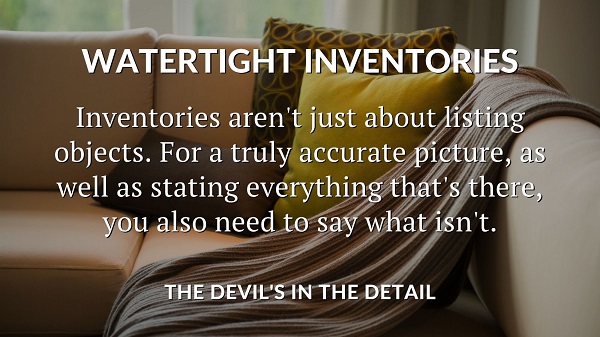
Minor scuffs that don’t yet warrant any remedial works should be mentioned along with exactly where they are on a wall or paintwork. The same goes for marks on a carpet or floor that aren’t serious but are nonetheless visible: be very clear about exactly where they are. And when it comes to stains, whether relatively unobtrusive or relatively obvious, make sure to measure them as well as mention them, and to state their exact location.
Accidents happen, and a couple of more common mishaps are irons on floors and saucepans on worktops. So it’s really worth mentioning that there are no burn marks: not just to state the truth, but to plant the seed in the minds of your tenants to be mindful of where they leave hot objects.
Where bathrooms and kitchens are free of mould and limescale, be sure to mention that too. Again, it’s a clear statement that everything is looking good and provides a gentle reminder for your tenants to keep their eyes peeled.
By being ultra-specific and going into detail, you minimise the potential for uncertainty in the future.
PHOTOGRAPH EVERYTHING
You can never have too many pictures. One of the biggest mistakes landlords make is taking a single photograph of each room, often because they see nothing to mention on the inventory - a quick note that everything’s fine, and then onto the next room.
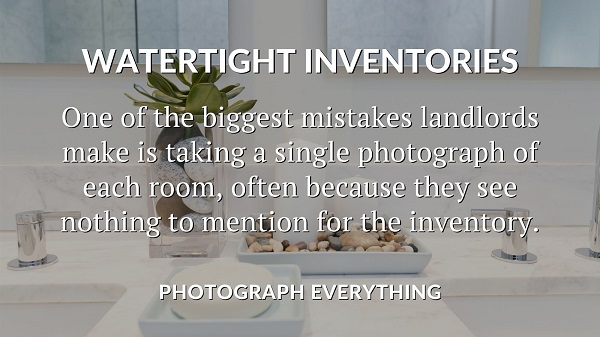
How can you take a photo of a scuff mark that isn’t there, or damage that doesn’t exist, or a breakage that hasn’t occurred? Well, you can’t, but you can take photos to show that all those things are in perfect condition. It’s not enough to say it; you need to show it.
As well as photographs, videos are easier than ever to take from your phone. Wander around your property and get close-ups of everything: switches, sockets, hinges, handles, walls, skirting boards, bathroom fittings, kitchen cupboards and appliances, heating systems, floor coverings, window frames, gardens.
Share them with your tenants, agree on their accuracy, and then sign them off together. By showing how responsible you are as a landlord and leaving nothing to chance, you give your tenants certainty of not being charged for anything unfair, and you send a clear message of how they should return your property.
HIDDEN BENEFITS
We generally speak of inventories as a failsafe in disputes, but they also play another role.
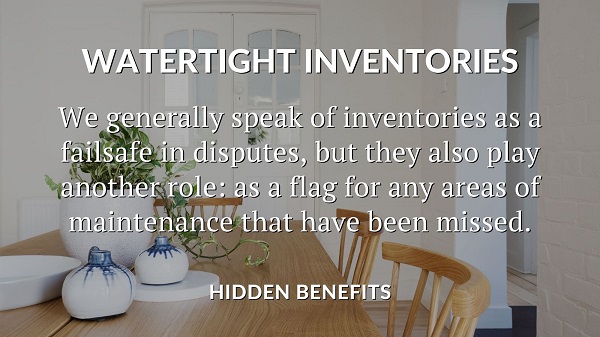
Properties need to be regularly maintained, and inventories can act as a flag for any maintenance areas that have gone unnoticed. If you’ve just bought a previously-occupied property, the previous owner’s belongings could have covered up some marks or damage. Or if you’ve owned your property for a while, you may simply have missed or become used to something.
Here’s another advantage of an inventory clerk, whose sole purpose is to visit properties to find flaws. By providing a fair and detailed report, they can also alert you to any areas needing attention. Nobody notices everything, and the clerk will give you an extra pair of extremely beady eyes to help you keep your rental property looking fine without having to go there.
Just because something is broken or damaged at the start of a tenancy doesn’t mean it has to stay that way for the duration. Instead of telling your tenants to make do, you’ll do wonders for your relationship – and your property’s value – by staying on top of repairs.
In summary
You’ve undoubtedly heard of the phrase prevention is better than cure. It’s a mantra for doctors worldwide and is a foundational factor in the explosion of the health and well-being industry.
By applying that same principle to your rental property, you’ll minimise unnecessary conflicts or disputes. Detailed and accurate paperwork, photo and video evidence, sensible language about the condition and enthusiastic maintenance will save you many potential headaches by removing any areas of doubt.
Inventories might not be the most exciting subject, but we’ll still gladly talk about them! If you’ve got a rental property in the Salisbury area and you’d like to know more about inventories or any other aspect of buy-to-let, you’re very welcome to get in touch. Call us for a chat on 01722 580059 or email info@piccoloproperty.co.uk - we’d love to help you make the most of being a landlord.


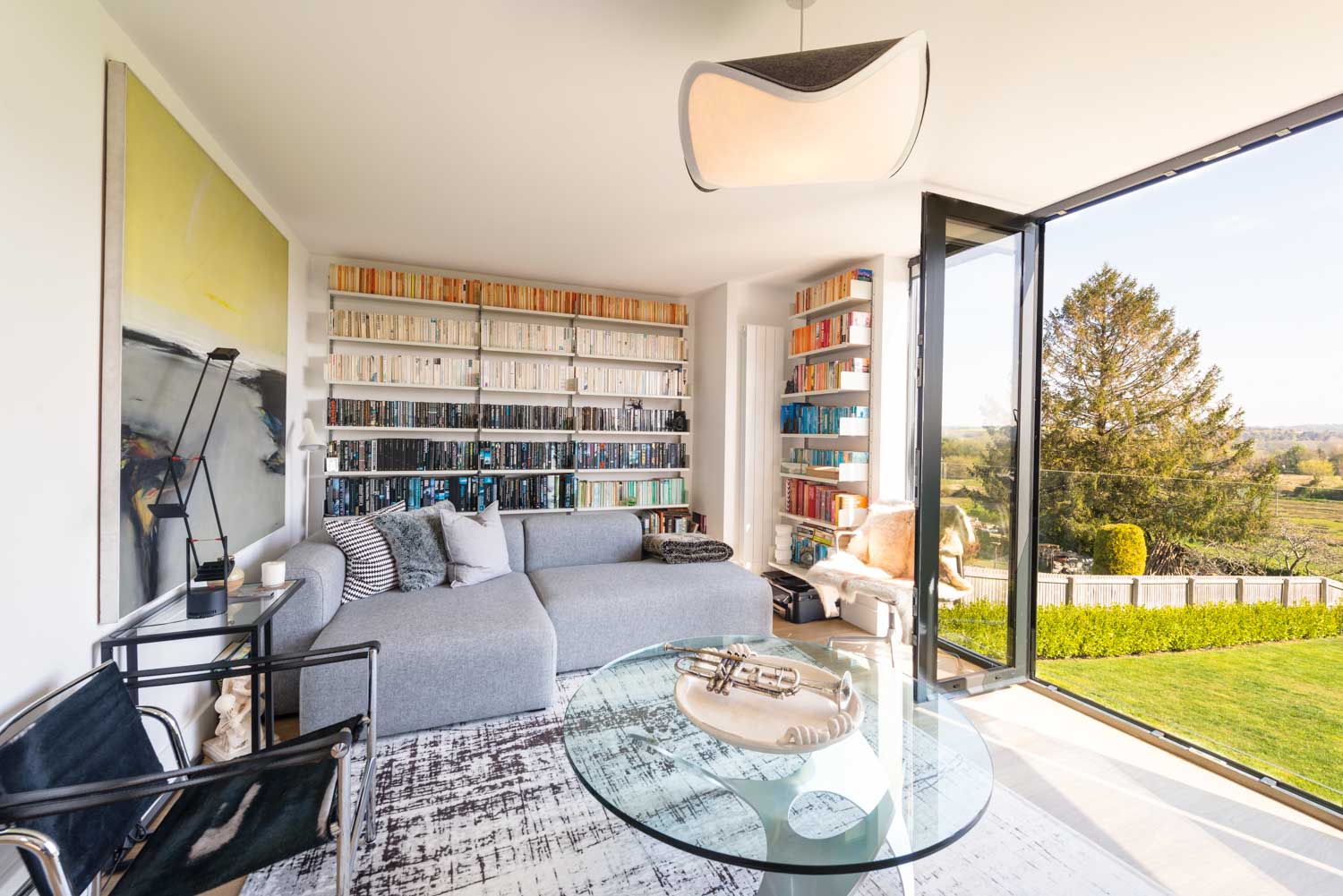

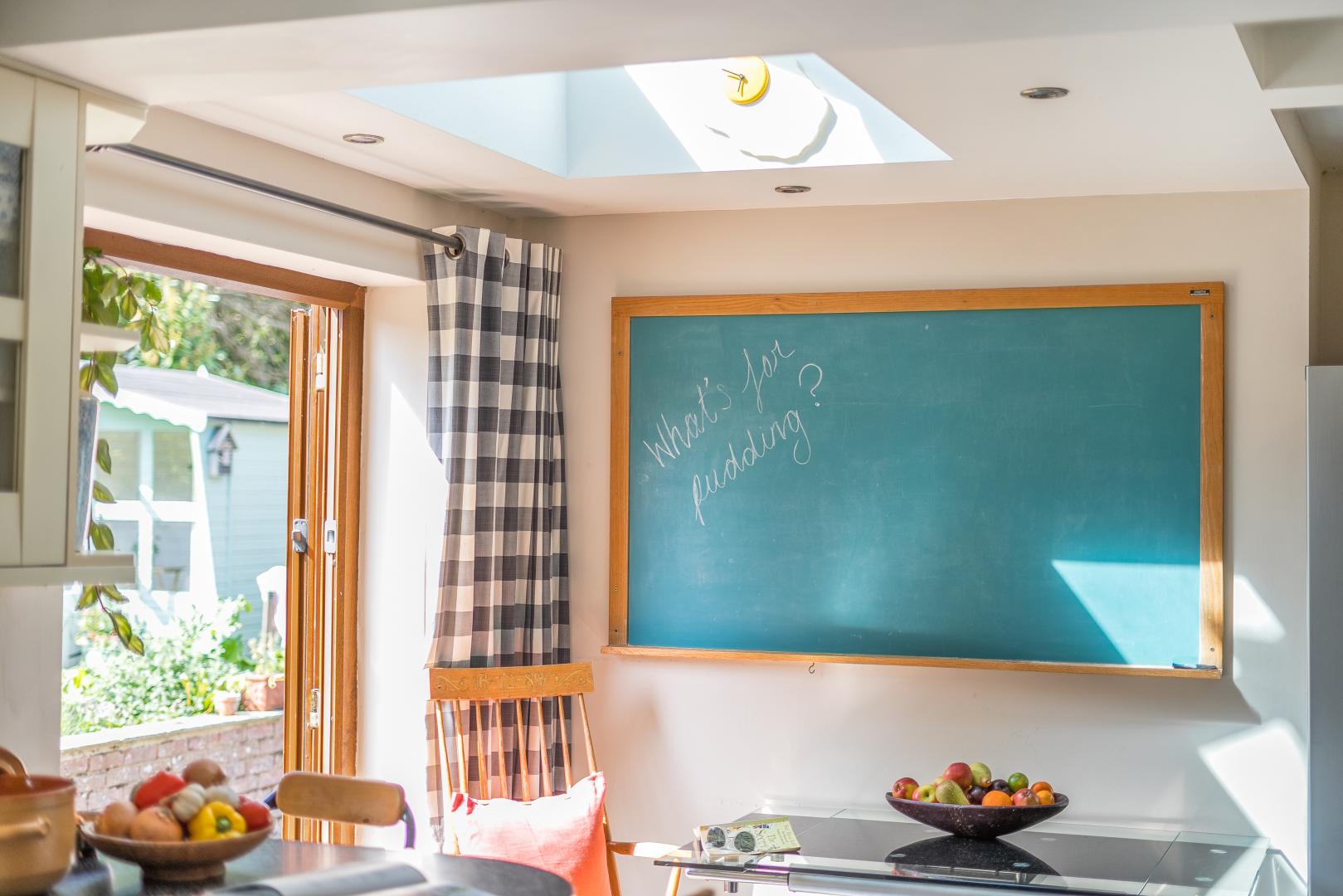

Share this with
Email
Facebook
Messenger
Twitter
Pinterest
LinkedIn
Copy this link